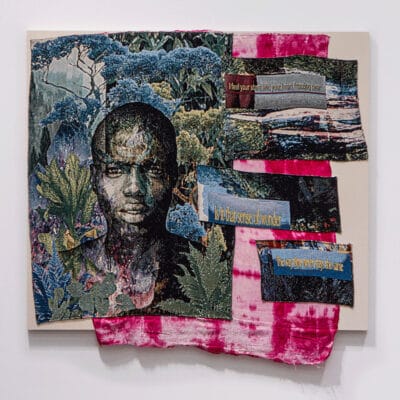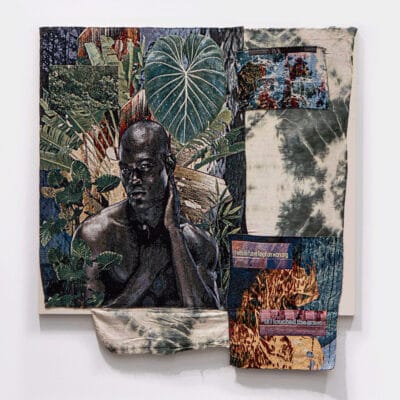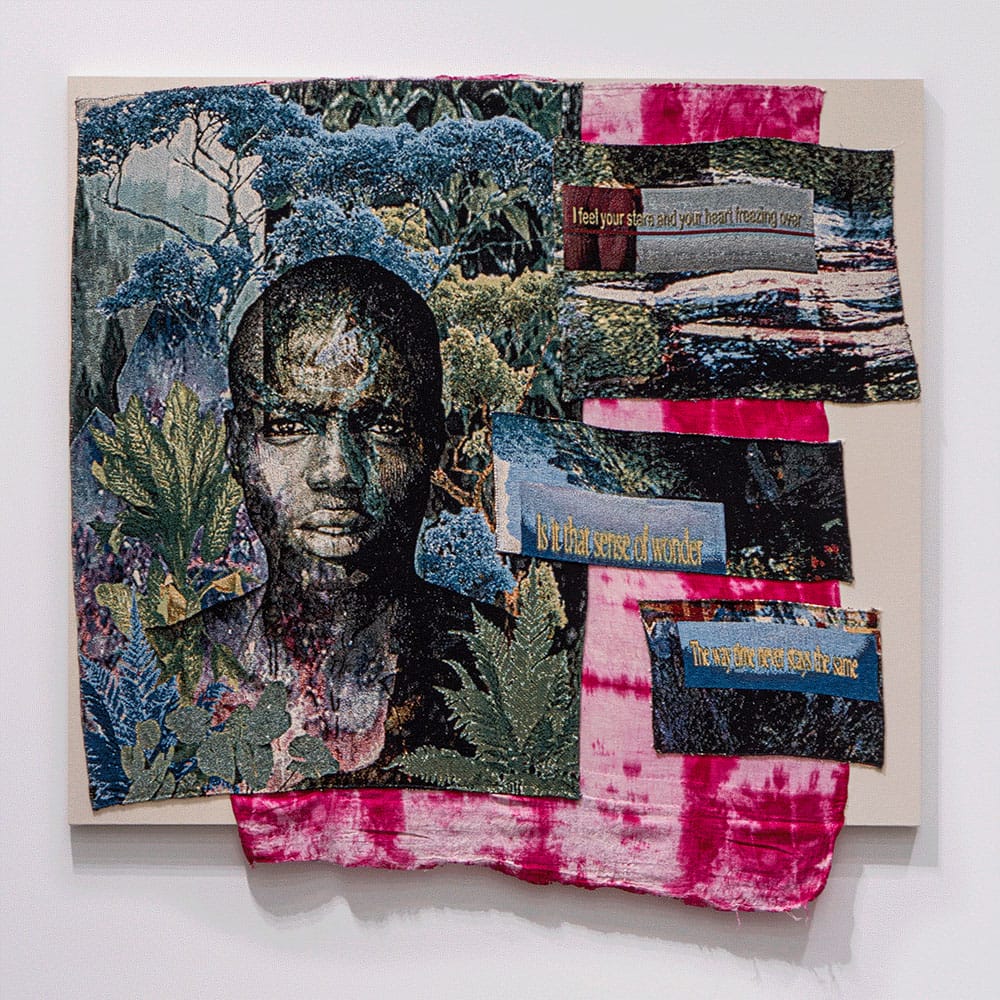Yossi Milo Gallery is delighted to present A Lacquered Egress, Richard-Jonathan Nelson’s debut solo exhibition in New York City and his first with the gallery. The show will open with an artist’s reception on Friday, December 9, 2022 from 6–8 PM and will be on view through Saturday, January 28, 2023.

Multimedia artist Richard-Jonathan Nelson’s (b. 1987; Savannah, GA) tapestries expand understandings of Blackness through Afrofuturist vision, boundless fantasy, and a reconstruction of the imagined spaces that hold Black bodies. Nelson’s experience with textile work dates back to his childhood in Savannah, Georgia, when his mother and grandmother taught him to sew. Stitching together different materials, the artist discovered how sewing could allow him to build his own worlds where queer Black bodies could exist outside of the Western colonial imagination. Today, the artist employs the processes of Jacquard weaving, applique, digital printing, and textile dyeing to create landscapes that are at once familiar and foreign: portals into sacred spaces which contain the potential to manifest a resilient Black existence which acknowledges trauma and envisions a path forward towards fantastical liberation.
Exploring notions of place, space, and identity, A Lacquered Egress embeds Nelson’s personal experience of displacement within broader histories of forced migration and exodus. As a young adult, the artist relocated from his native Georgia to the San Francisco-Bay Area; with its booming technology industry, the region offered an opportunity for economic success, as well as a refuge from the more conservative traditionalism that filled his youth. Upon settling there, however, the artist became aware of the limited opportunities afforded to those excluded from the wealthy, largely white circles that dominate the region. Nelson witnessed how many of his peers were unable to stay in the area and, due to socioeconomic pressures in San Francisco, were forced to move once more. In response, Nelson developed his artistic practice as a means of futurist vision, visualizing spaces where queer Black people can exist untethered and unencumbered by the materially and socially harsh conditions that predominate today.

In the worlds he builds from fabric, Nelson forges new psychic spaces for queer Black men to inhabit. Forest bathing was too costly, to far too heavy a burden to carry (2022) presents the image of a man who gazes softly out at the viewer, surrounded by lush greenery and noisy passages of highly-saturated color. The artist sources images of tenderly-depicted Black men from old print publications, vintage adult magazines, and open-source online image bases, selecting those that frame Black masculinity with an openness and vulnerability that is typically denied under the Western gaze. Here, the subject is surrounded by images of tropical palms and Acacia trees, a highly resilient, thorny species of tree native to Africa. These elements make reference to both the African diaspora as well as the defense mechanisms that queer Black people have adapted into their daily lives. Such mechanisms are both forms of protection and decorative ornamentation: methods of survival that have become integral to queer liberation, as seen in communities of drag queens and queer performers. Nelson fortifies these traditions in his work to build sanctuaries for queer Black people who often struggle to find permanent sites of safety.
Nelson invokes notions of futuristic travel as well as the threat of catastrophe that haunted his youth with images of alternate realities and extraterrestrial explosions that punctuate his compositions. Brought up in the Southern Evangelical Church, the threat of Armageddon loomed large and persisted into the artist’s adulthood due to racist attitudes, classicism, and socio-cultural misinterpretations in his environment. Drawing from science-fiction novels and graphics, Nelson captures this feeling by placing images of extraterrestrial disasters around his Black subjects. In Trees were clearly present, but misinterpreted (2022), a celestial explosion stands in contrast to a seemingly tranquil view of two planets in space. The juxtaposition raises the question: is outer space a site of danger and annihilation, or endless opportunity? Nelson presents this question throughout his work, allowing the subjectivity of each viewer to lead them to their own conclusion. In his work, excerpts of text taken from the closed captions of queer films and music videos offer some clue of his own thinking, but ultimately remain cryptic in their poeticism. Collectively, these elements come together in a material sense to build a new aesthetic of Blackness, one that is gentle and soft-spoken, yet asks pointed questions about future directions for queer Black liberation.
Richard-Jonathan Nelson (b. 1987; Savannah, GA) presented his first solo museum exhibition, Interlacing distributed intelligence/noir care, at the Museum of the African Diaspora, in San Francisco, CA. He has had solo exhibitions across the country, including at Aggregate Space Gallery, in Oakland, CA and the Jewish Educational Alliance in Savannah, GA. His work has been featured in group exhibitions at Embark Gallery, San Francisco, CA; Hive Gallery, Los Angeles, CA; and Headlands Center for the Arts, Marin County, CA, among others. He is the recipient of the 2018 Methods of Acti(ng)on: CCA Alumnx Residency Open Studio Award and the 2015 Byron Meyer Scholarship. The artist received his MFA from California College of the Arts in 2017, and his BFA from Georgia State University in 2011. The artist currently lives and works in Oakland, CA.
Yossi Milo Gallery
245 10th Ave, New York, NY 10001
